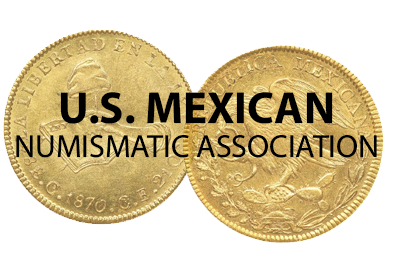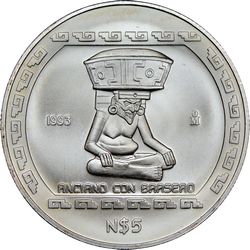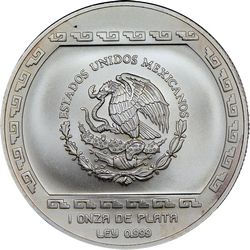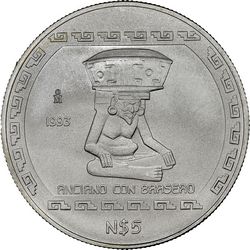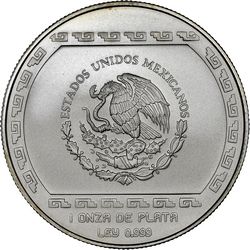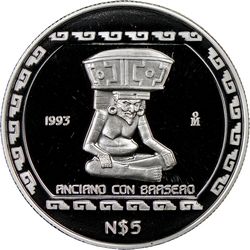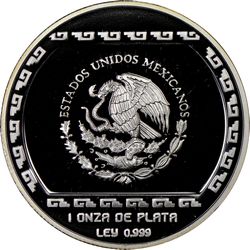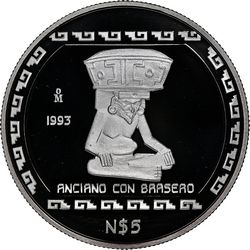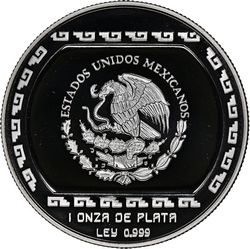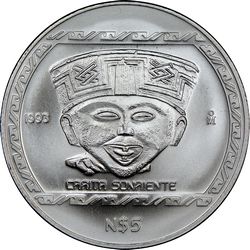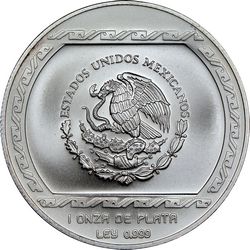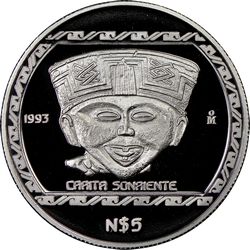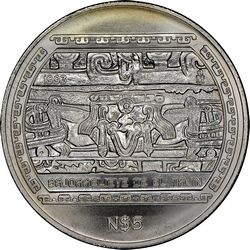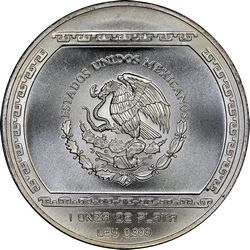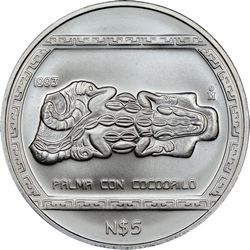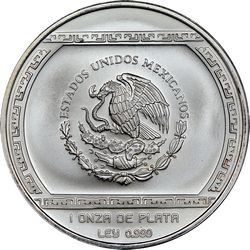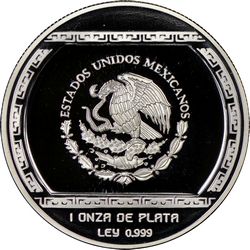Pre-Columbian Series – Central Veracruz Collection – Silver 1 Oz. (Uncirculated & Proof)
by Alberto Rodriguez
Introduction
This second article of this multi-part series, on the Pre-Columbian series for 1 ounce silver coins, will cover the Central Veracruz collection.
Two factors obscure collectors’ understanding of mintages for this particular series. Both online coin directories and authoritative catalogs only publish the original mintages from when the coins were first released, but leave out published restrikes, by the Banco de México. The Pre-Columbian series, in fact, minted additional strikes in the years 2000 to 2011. The other factor is what I have called the Melted Factor. Anecdotally several folks in the business, both in Mexico and the United State, have suggested that during the parabolic silver price run up of 2010-2011, 35%-50% of silver Pre Columbians had been melted. Further evidence from Mexican coin collectors and old online message board posts suggests this series was long treated like bullion and has long sold for spot. Many of the surviving pieces also have evidence of acid tests on the surface. Taking this Melted Factor into consideration provides a more accurate representation of available mintage today.
The Central Veracruz Collection
The Central Veracruz Collection, the second collection in the Pre-Columbian series, was issued in 1993. Unlike the Aztec Collection, the Central Veracruz issues were denominated only in new pesos from the outset, so there was no need to reissue them to conform with the Coinage Reform of 1992. The Totonac Indians built a very complex civilization in the northern part of Mexico, around the year 1000 B.C., deeply influenced by Teotihuacán. In the political dimension El Tajín was a city of at least 2,600 acres. the capital of a centralized tribute state, and at its apogee controlling much of present-day north central Veracruz and adjoining portions of the state of Puebla. Additionally, it was a religious, artistic, architectural and engineering center of first magnitude in ancient Mexico. The Veracruz Classic period is noted among other things for the creation of a sculptured complex Yugoo-Hacha-Palma. These sculptures are associated with the Juego de Pelota - a Prehispanic ritual ball game played by the Mesoamerican Indians – and are included as some of the most outstanding stone sculptures of Totonac art.
During the early 13th century El Tajín was attacked and burned, possibly by the Chichimecas. The Totonacs abandoned the city and resettled in the surrounding area. During the 15th century they were forcibly absorbed into the Aztec empire and required to pay tribute, in the form of both goods and humans (for slaves or sacrifice), to the Aztec capital, Tenochtitlán.
Anciano con Brasero
The Anciano con Brasero is a seated elderly man with a brazier atop his head, representing the god of fire, who was worshipped across most pre-Columbian cultures. These sculptures, found in the Centro de las Mesas in the state of Veracruz, are made of terracotta, sometimes at life size. They have distinct elements of both Totonac and Teotihuacán styles, indicating the strong relationship between the two cultures. The one from which the coin design is taken is held in the National Museum of Anthropology.
The 1-ounce silver Anciano con Brasero design was issued in 1993. The design was issued in the new 5 pesos denomination in both Brilliant Uncirculated and Proof. Both formats were struck in two varieties. The varieties are recognized by numismatic catalogs such the Whitman Encyclopedia of Mexican Money, but not the Standard Catalog of World Coins. However, these catalogs only publish original mintages and leave out restrikes from consideration.
Anciano con Brasero – Brilliant Uncirculated (BU) Variety Overview
The Variety 1 Brilliant Uncirculated coin has a reverse with an old man sitting cross-legged in three-quarter profile to the right, balancing a large brazier on his head, with the date to the left and the mintmark to right (MMR). ANCIANO CON BRASERO is displayed on the exergue below. Surrounding the field is an ornamental border, based on patterns in the bas-reliefs found in the El Tajín zone, with the $5 below. Variety 2 Brilliant Uncirculated has a reverse with both the date and mintmark to left (MML).
The obverse of these varieties displays the national coat of arms with the eagle facing left, the legend ESTADOS UNIDOS MEXICANOS above, and below it, a half-wreath of oak and laurel. Surrounding the field is the ornamental border discussed above. Below the border is displayed 1 ONZA DE PLATA, and further below LEY 0.999.
Variety 1 (MMR)
$5 New Pesos Raised Denomination
Variety 2 (MML)
$5 New Pesos Raised Denomination
There were 3,200 - 3,800 original strikes for 1993 varieties combined. There is a bit of variance between sources on these figures. The Standard Catalog of World CoinsMichael, Thomas, Tracy L. Schmidt, and Richard Giedroyc 2019 Standard Catalog of World Coins. Stevens Point, WI: Krause Publications, 2018. only acknowledges Variety 1 (MMR) and has published 3,800 as the total mintage. Whitman’s Encyclopedia of Mexican MoneyBailey, Don, and Lois. Whitman Encyclopedia of Mexican Money, Volume 2: Modern Coins of Mexico, 1905 to Date. Atlanta, GA: Whitman Publishing LLC, 2015. recognizes both varieties with a published mintage of 1,500 and 1,700 for both varieties respectively, for a total of 3,200. Numista’s online cataloghttps://es.numista.com/catalogue/index.php?ct=coin&se=Bullion+Coinage+-+Pre-Columbian+Central+Veracruz&e=mexique supports the latter figures. This compilation of figures makes it a slightly cumbersome task to reconcile original mintage figures. The Banco de MéxicoBanxico.org.mx Economic Information System (SIE) Coins and Medals – CM27, Annual, Pieces, Flows. currently has published mintage numbers on their website only for the year 2000 and onward. Given the agreement between Whitman’s and Numista, we will publish this set of figures and apply their Variety 1 to Variety 2 ratio. Both Bailey’s and Numista’s raw figures suggest Variety 1 is scarcer, but Numista’s user frequency statistics suggest Variety 2 is scarcer. My personal experience with this particular coin, considering the ones I own and what I have seen available for sale, is that Variety 1 is definitely harder to come by.
The additional strikes from the years 2000 – 2011 are published on the Banco de México’s website but lack distinction between varieties. The total additional strikes are 2,300. We will distribute this total between varieties, once again applying Bailey’s ratio. With the additional strikes in subsequent years, the grand total combined per variety is 2,578 and 2,922 respectively.
Applying the melted factor, discussed in the introduction, (35-50%), leaves us with an estimated survival mintage of 1,289-1,676 for the Variety 1 and 1,461-1,900 for the Variety 2. Collating all the aforementioned figures results in the following table:
| 1oz Silver MS Pre-Columbian Series - Anciano Con Brasero | |||||
| Original Mintage | Restrikes | Total Including Restrikes | Estimated Minimum Surviving | Estimated Maximum Surviving | |
| 1993 5 Pesos Variety 1 MMR | 1,500 | 1,078 | 2,578 | 1,289 | 1,676 |
| 1993 5 Pesos Variety 2 MML | 1,700 | 1,222 | 2,922 | 1,461 | 1,900 |
Anciano con Brasero – Proof Variety Overview
There are also two varieties of the 1oz Anciano con Brasero Proofs. Both varieties share the same coin elements as their Brilliant Uncirculated counterparts but are further distinguished by a mirrored inner field and border area on both sides with a raised and frosted denomination on the reverse as well as a raised and frosted legend on the obverse.
Variety 1 (MMR)
$5 New Pesos Raised Denomination
Variety 2 (MML)
$5 New Pesos Raised Denomination
We again encounter similar differences between sources regarding original mintage for the proofs. The Standard Catalog of World Coins again only acknowledges Variety 1 (MMR) and has published 4,160 as the total mintage. Whitman’s Encyclopedia of Mexican Money recognizes both varieties with a published mintage of 1,500 and 2,160 for both varieties respectively, for a total of 3,660. Numista’s online catalog supports the latter figures as well. Both Bailey’s and Numista’s raw figures suggest Variety 1 is scarcer. This time Numista’s user frequency statistics also suggest Variety 1 is scarcer.
The additional strikes from the years 2000 – 2011 published with no distinction between varieties amount to 1,500. We will distribute this total between varieties, once again applying Bailey’s ratio. With the additional strikes in subsequent years, the grand total combined per variety is 2,115 and 3,045 respectively.
Applying the melted factor leaves us with an estimated survival mintage of 1,058-1,375 for the Variety 1 and 1,523- 1,979 for the Variety 2. The figures gathered above result in the following table:
| 1oz Silver PF Pre-Columbian Series - Anciano Con Brasero | |||||
| Original Mintage | Restrikes | Total Including Restrikes | Estimated Minimum Surviving | Estimated Maximum Surviving | |
| 1993 5 Pesos Variety 1 MMR | 1,500 | 615 | 2,115 | 1,058 | 1,375 |
| 1993 5 Pesos Variety 2 MML | 2,160 | 885 | 3,045 | 1,523 | 1,979 |
Carita Sonriente
The Carita Sonriente (Smiling Face) is one of the most widely found art products of the Central Veracruz culture. These small, terracotta figurines, with their distinctive triangular heads and puffy, smiling faces, are often found in tombs. Explanations for their purpose vary. One is that they were thought to have magical powers that would aid the dead in the afterlife. Another suggests they represent drugged individuals (hence the puffy features) being prepared for sacrifice. The Smiling Face on which the coin design is based is held in the National Museum of Anthropology.
The 1-ounce silver Carita Sonriente, like all other Central Veracruz collection coins, were issued in 1993. The design was issued in a single variety in the new 5 pesos denomination in both Brilliant Uncirculated and Proof.
Carita Sonriente – Brilliant Uncirculated (BU) Variety Overview
The uncirculated coin has a reverse with the smiling head at the center, with the date to the left and the mintmark to right (MMR). CARITA SONRIENTE is displayed on the exergue below. Surrounding the field is an ornamental border, based on patterns in the bas-reliefs found in the El Tajín zone, with the $5 below. The obverse is identical to its Central Veracruz collection counterparts, with the exception of the coin border, in which the patterns are unique to each coin in the collection.
$5 New Pesos (MMR) Raised Denomination
There were 4,500 - 5,105 original strikes for the Brilliant Uncirculated Carita Sonriente. Again, there is a bit of variance between sources on these figures. Both Whitman’s and the Standard Catalog of World Coins have published 5,105 as the original mintage. This time, it is Numista that diverges from this mintage figure with 4,500. Given the agreement between Whitman’s and the Standard Catalog of World Coins, the figure of 5,105 will be published here.
The additional strikes from the years 2000 – 2011 published on the Banco de México’s website amount to 3,600. The grand total combined original mintage plus restrikes is 8,705.
Applying the melted factor leaves us with an estimated survival mintage of 4,353-5,658. A summary of these figures is shown as follows:
| 1oz Silver MS Pre-Columbian Series - Carita Sonriente | |||||
| Original Mintage | Restrikes | Total Including Restrikes | Estimated Minimum Surviving | Estimated Maximum Surviving | |
| 1993 5 Pesos MMR | 5,105 | 3,600 | 8.705 | 4,353 | 5,658 |
Carita Sonriente – Proof Variety Overview
The proof variety shares the same coin elements as its Brilliant Uncirculated counterpart but is further distinguished by a mirrored inner field and border area on both sides with a raised and frosted denomination on the reverse as well as a raised and frosted legend on the obverse.
$5 New Pesos (MMR) Raised Denomination
We again encounter similar differences between sources regarding original mintage for the proofs. Both Whitman’s Encyclopedia of Mexican Money and the Standard Catalog of World Coins have published 4,705 as the original mintage. Numista again deviates from this mintage figure with 3,300. Given the agreement between Whitman’s and the Standard Catalog of World Coins, the figure of 4,705 will be published here.
The additional strikes from the years 2000 – 2011 aggregate to 2,100. With these additional strikes in subsequent years, the grand total combined is 6,805.
Applying the melted factor leaves us with an estimated survival mintage of 3,403-4,423. The figures gathered above are shown in the following table:
| 1oz Silver PF Pre-Columbian Series - Carita Sonriente | |||||
| Original Mintage | Restrikes | Total Including Restrikes | Estimated Minimum Surviving | Estimated Maximum Surviving | |
| 1993 5 Pesos MMR | 4,705 | 2,100 | 6,805 | 3,403 | 4,423 |
Similar to the speculation in my first article regarding an alleged Brasero Efigue (MMR) with a $5 New Pesos Incused denomination, where no graded example or undisputed evidence exists, this series also has its mystery coin. In 2021, a user on Numista uploaded images contending there is another Carita Sonriente proof variety, specifically one with an incused denomination. Two of those images shown below, with sections enlarged, imply no such exist, and the images are simply manipulated.
Carita Sonriente
Variety Unconfirmed (MMR)
$5 New Pesos
Incused Denomination Numista Proof Enlarged images
Fellow USMexNA member, Felix Kirzhner, mentions that the biggest giveaway is that the design of the incuse image is completely inconsistent with every incuse Pre-Columbian coin produced. The chevron patterns on left and right side of the coin showcase images are always raised above the surface of the coin on a frosted background. On this coin it is not. In the first zoomed image above, the supposed raised feature on the right is actually below the field, while on the second image it is above the field, with both images asserted by the user to be of the same coin. These images are inconsistent and would never be randomly designed this way. It is hard to believe such a design can be executed at the die level to produce this coin with a raised feature falling below the field. Based on the aforementioned observations one can conclude that the coin images are manipulated and not those of a real coin.
Variety Unconfirmed (MMR)
$5 New Pesos Numista Proof
Bajorrelieve de El Tajín
In the central section of El Tajín are the remains of 13 courts once used for the ritual ball-game played by the Totonacs. On the vertical walls of the south ball court is a bas-relief (el Bajorrelieve de El Tajín) depicting scenes of the ceremonial game interwoven with scrolls and bands. A section from this bas-relief is depicted on the 1oz silver coins. This coin design was issued in a single variety in the new 5 pesos denomination in both Brilliant Uncirculated and Proof.
Bajorrelieve de El Tajín – Brilliant Uncirculated (BU) Variety Overview
The Uncirculated coin has a reverse with a section of decorative bas- relief nearly filling the entire field, surrounded by decorative borders found on patterns in other bas-reliefs found in El Tajín. The date is present to the left and the mintmark to the right (MMR) within the upper portion of the decorative bas-relief. The exergue BAJORRELIEVE DE EL TAJÍN is found below the decorative bas-relief and just above the bottom decorative border, with N$5 below. The obverse is identical to its Central Veracruz collection counterparts, with the exception of the coin border, in which the patterns are unique to each coin in the collection.
$5 New Pesos (MMR) Raised Denomination
There were 100,000 – 101,005 original strikes for the brilliant uncirculated Bajorrelieve de El Tajín. Again, there is a bit of variance between sources on these figures. Both Whitman’s Encyclopedia of Mexican Money and the Standard Catalog of World Coins have published 101,005 as the original mintage. Numista diverges from this mintage figure with 100,000. Given the agreement between Whitman’s Encyclopedia of Mexican Money and the Standard Catalog of World Coins, the figure of 101,005 will be published here.
The additional strikes from the years 2000 – 2011 published on El Banco de México’s website amount to 1,000. The grand total combined original mintage plus restrikes is 102,005.
Applying the melted factor of 35-50% leaves us with an estimated survival mintage of 51,003-66,303. A summary of these figures is shown as follows:
| 1oz Silver MS Pre-Columbian Series - Bajorrelieve de El Tajín | |||||
| Original Mintage | Restrikes | Total Including Restrikes | Estimated Minimum Surviving | Estimated Maximum Surviving | |
| 1993 5 Pesos MMR | 101,005 | 1,000 | 102,005 | 51,003 | 66,303 |
Bajorrelieve de El Tajín – Proof Variety Overview
The Proof Variety shares the same coin elements as its Brilliant Uncirculated counterpart but is further distinguished by a mirrored inner field and border area on both sides with a raised and frosted denomination on the reverse as well as a raised and frosted legend on the obverse.
Both Whitman’s Encyclopedia of Mexican Money and the Standard Catalog of World Coins have published 4,405 as the original mintage. Numista again deviates from this mintage figure with 3,000. Given the agreement between Whitman’s Encyclopedia of Mexican Money and the Standard Catalog of World Coins, the figure of 4,405 will be published here.
$5 New Pesos (MMR) Raised Denomination
The additional strikes from the years 2000 – 2011 aggregate to 2,100. With these additional strikes in subsequent years, the grand total combined is 6,505.
Applying the melted factor leaves us with an estimated survival mintage of 3,253-4,228. The figures gathered above are shown in the following table:
| 1oz Silver PF Pre-Columbian Series - Bajorrelieve de El Tajín | |||||
| Original Mintage | Restrikes | Total Including Restrikes | Estimated Minimum Surviving | Estimated Maximum Surviving | |
| 1993 5 Pesos MMR | 4,405 | 2,100 | 6,505 | 3,253 | 4,228 |
Palma con cocodrilo
The Palma con cocodrilo design is based on an artifact held in the National Museum of Anthropology. It reflects both the Gulf Coast landscape, where the Totonac civilization developed, and highlights the Totonacs’ fascination with the crocodile. The creature on the coin is viewed from above, with its tail curled back around in imitation of a palm frond. This coin design was issued in a single variety in the new 5 pesos denomination in both Brilliant Uncirculated and Proof.
Palma Con Cocodrilo – Brilliant Uncirculated (BU) Variety Overview
$5 New Pesos (MMR) Raised Denomination
The Uncirculated coin has a reverse with the figure of a crocodile with a curled tail, with the date to the left and the mintmark to right (MMR). PALMA CON COCODRILO is displayed on the exergue below. These details are surrounded by an ornamental border, with N$5. The obverse is identical to its Central Veracruz collection counterparts, with the exception of the coin border, in which the patterns are unique to each coin in the collection.
There were 4,500 - 5,105 original strikes for the Brilliant Uncirculated Palma con Cocodrilo. Both Whitman’s Encyclopedia of Mexican Money and the Standard Catalog of World Coins have published 5,105 as the original mintage, while Numista has published 4,500. Given the agreement between Whitman’s Encyclopedia of Mexican Money and the Standard Catalog of World Coins, the figure of 5,105 will be published here.
The additional strikes from the years 2000 – 2011 published on the Banco de México’s website amount to 3,600. The grand total combined original mintage plus restrikes is 8,705.
Applying the melted factor of 35-50% leaves us with an estimated survival mintage of 4,353-5,658. A summary of these figures is shown as follows:
| 1oz Silver MS Pre-Columbian Series - Palma con Cocodrilo | |||||
| Original Mintage | Restrikes | Total Including Restrikes | Estimated Minimum Surviving | Estimated Maximum Surviving | |
| 1993 5 Pesos MMR | 5,105 | 3,600 | 8,705 | 4,353 | 5,658 |
Palma Con Cocodrilo – Proof Variety Overview
The Proof Variety shares the same coin elements as its Brilliant Uncirculated counterpart but is further distinguished by a mirrored inner field and border area on both sides with a raised and frosted denomination on the reverse as well as a raised and frosted legend on the obverse.
Both Whitman’s and the Standard Catalog of World Coins have published 3,855 as the original mintage. Numista again deviates from this mintage figure with 2,650. Given the agreement between Whitman’s Encyclopedia of Mexican Money and the Standard Catalog of World Coins, the figure of 3,855 will be published here.
The additional strikes from the years 2000 – 2011 published on El Banco de México’s aggregate to 1,400. With these additional strikes in subsequent years, the grand total combined is 5,255.
$5 New Pesos (MMR) Raised Denomination
Applying the melted factor leaves us with an estimated survival mintage of 2,628-3,416. The figures gathered above are shown in the following table:
| 1oz Silver PF Pre-Columbian Series - Palma con Cocodrilo | |||||
| Original Mintage | Restrikes | Total Including Restrikes | Estimated Minimum Surviving | Estimated Maximum Surviving | |
| 1993 5 Pesos MMR | 3,885 | 1,400 | 5,255 | 2,628 | 3,416 |
Summary
This completes my second article on the Pre-Columbian series for 1 ounce silver coins. This by no means is an authoritative guide but it does address the deficiencies not addressed in some of the references cited. Four articles remain, honoring the remaining Pre-Columbian civilizations: Maya, Olmec, Teotihuacan, and Toltec.
To finish, I would like to recognize Felix Kirzhner, for his continued recommendations on various considerations, and Scott Doll whose encouragement inspired me to begin writing this series. I would also like to thank him for sharing the coin images shown in this article. I would also like to acknowledge Doug Plasencia at Numismatic Guaranty Company (NGC) for his work on the set of NGC PhotoVision high resolution coin images shared by Scott.
Please send your comments, questions, or suggestions regarding this article, to me at
